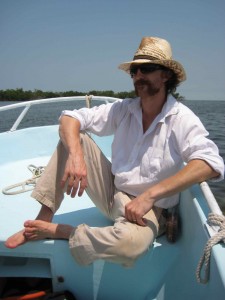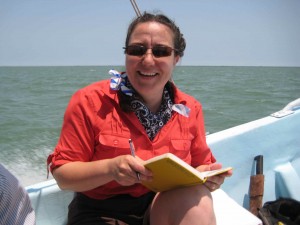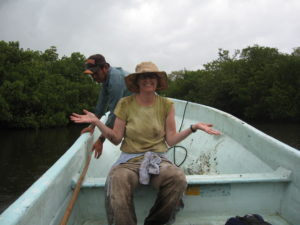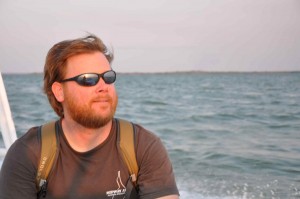Principal Investigators
Jeffrey B. Glover, Ph.D. (Georgia State University)
I am currently an Associate Professor in the Department of Anthropology at Georgia State University. My interest in Anthropology started when I was an undergraduate at Vanderbilt University. Following Vanderbilt I joined the Ph.D. program at the University of California, Riverside (UCR). At UCR I began working in northern Quintana Roo as a member of the Yalahau Regional Human Ecology Project. It was at UCR where I met Dominique Rissolo. Our mutual experiences conducting archaeological research in Quintana Roo and our shared interests led us to develop the Proyecto Costa Escondida in 2006. I have also been fortunate to work on other projects in Oaxaca, Tabasco, El Salvador, and Georgia. Upon graduation, I was lucky enough to land a teaching job at Georgia State University in my hometown of Atlanta. When not working in Mexico, I have enjoyed working on local projects in and around Atlanta. My “copious” spare time is mainly spent playing with my two young boys. I also enjoy water-related activities like surfing and fly-fishing.
Dominique Rissolo, Ph.D. (University of California, San Diego)
Dominique Rissolo is an archaeologist and special projects coordinator at the Center of Interdisciplinary Science for Art, Architecture, and Archaeology (CISA3), which is part of the Qualcomm Institute at the University of California, San Diego. Prior to coming to UCSD, Dominique oversaw the acquisition and management of a deep submergence capability for the Waitt Institute, in partnership with Woods Hole Oceanographic Institution, and worked closely with agencies and universities to plan and execute oceanographic and marine archaeological survey and research projects using AUV, ROV, HOV, R/V platforms. As an archaeologist, Dominique’s interdisciplinary research focuses on paleocoastal human ecology and the development of ancient maritime trade networks along the Yucatan coast. His work on the Yucatan Peninsula has also focused on ancient Maya and Paleoamerican cave and cenote use as well as coastal and near-coastal settlement patterns and the rise of social complexity in the region. Dominique is an adjunct professor at San Diego State University (Department of Anthropology) and McMaster University (School of Geography and Earth Sciences). Dominique also serves on the NOAA Ocean Exploration Advisory Board and continues to work closely with National Geographic. Dominique enjoys rock climbing, scuba diving, and foraging for edible plants in the canyons around campus.
Patricia Beddows, Ph.D. (Northwestern University)
Trish specializes in karst geology and hydrology – which means she has an inordinate fondness for cave systems, and even more so for those filled with water that she explores as a cave diver. Her studies over the last 20 years in the Yucatan Peninsula have focused on the formation of caves, the dynamic response of the groundwater aquifer to the ocean and climate patterns, reconstruction of the past environment, water supplies and pollution tracking, and geoarcharchelogy projects. Trish, along with Edward Mallon, have been developing and deploying an open-sourced Arduino-based instrument network over the eastern Yucatan Peninsula (see www.youtube.com/watch?v=kJGhwMB4eew), which will now be extended to cover the north coast in the search for the current and past water resources used by the Maya. In addition to Costa Escondido, she is currently also contributing to the study of Naia (along with Dominique), the oldest dated complete human skeleton in North America found deep in a cave at more than 40 m water depth, alongside numerous animals such as saber tooth cat to gomphothere (a species similar in shape and size to a small mammoth). Trish is an Assistant Professor of Instruction, and also the Assistant Chair in the Department of Earth and Planetary Sciences at Northwestern University in Evanston, IL.
 Beverly Goodman, Ph.D. (University of Haifa)
Beverly Goodman, Ph.D. (University of Haifa)
Beverly Goodman-Tchernov is a marine geoarchaeologist and Assistant Professor in the Department of Marine Geosciences at the Leon Charney School of Marine Sciences in the University of Haifa, Israel. My primary geographical research area is the Eastern Mediterranean, where I specialize in the reconstruction of harbors, tsunami histories, sea-level and understanding the interrelationships between people and the ever-changing coastline. I focus on a combined approach incorporating archaeological information with traditional sedimentology, micropaleontology, and geochemistry. At present, in addition to Vista Alegre, sample bags cluttering the tables of my laboratory span from meteorite-driven tsunami deposits from Dallas, sewage that was once dumped offshore during the Christian-Era of Roman Caesarea, Minoan kitchen debris following the eruption of Thera, and Phoenician funerary ceramics that were swept up by the sea, and many other tales waiting to be told. I made the acquaintance of Dominique Rissolo at National Geographic when he was the session facilitator when I presented as an incoming emerging explorer, and next thing I knew I was landing in Quintano Roo with mosquito repellent and a fieldbook. At Vista Alegre I am drawing on the knowledge gained in the Mediterranean to help better reconstruct the landscape and maritime activity zones of the site. At the moment, my spare time has been outsourced to my sons, so it usually involves popcorn, Legos and/or Star Wars.
Jennifer P. Mathews, Ph.D. (Trinity University)
 Jennifer Mathews is a Professor of Anthropology in the Sociology and Anthropology Department at Trinity University, where she teaches courses in Archaeology and Biological Anthropology, including Introduction to Prehistoric Archaeology, Pre-Columbian Art of Mesoamerica, Seminar on the Ancient Maya, Human Evolution, Primatology, Anthropological Forensics, Anthropological Ethics, and Eating and Drinking in the 19th Century. She received her Masters and Ph.D. in Anthropology, with a specialization in Maya Archaeology from the University of California at Riverside. She co-directs the Yalahau Regional Human Ecology Project in Quintana Roo, Mexico and has been conducting fieldwork and archival research in Mexico since 1993. Although much of her research has focused on the ancient Maya, studying roads, architecture, and the layout of sites, more recently she has been focusing on the recent historic period of the Yucatán Peninsula (1850-1920), looking at food commodities like sugarcane and rum, and chicle (the base for chewing gum). She has written several journal articles and book chapters, and edited two books on Maya archaeology: “Quintana Roo Archaeology” (with Justine Shaw) and “Lifeways in the Northern Maya Lowlands: New Approaches to Archaeology in the Yucatan Peninsula” (with Bethany Morrison). She also published the book (with Gillian P. Schultz) entitled “Chicle: Chewing Gum of the Americas – From the Ancient Maya to William Wrigley.” Her next book will come out in spring of 2017, which is edited volume (with Tom Guderjan) on Maya commodities, from the prehistoric period to the present time, including jade, salt, chocolate, henequen, honey, rum, and handcrafts as well as a monograph on rum production in Mexico during the 19th century.
Jennifer Mathews is a Professor of Anthropology in the Sociology and Anthropology Department at Trinity University, where she teaches courses in Archaeology and Biological Anthropology, including Introduction to Prehistoric Archaeology, Pre-Columbian Art of Mesoamerica, Seminar on the Ancient Maya, Human Evolution, Primatology, Anthropological Forensics, Anthropological Ethics, and Eating and Drinking in the 19th Century. She received her Masters and Ph.D. in Anthropology, with a specialization in Maya Archaeology from the University of California at Riverside. She co-directs the Yalahau Regional Human Ecology Project in Quintana Roo, Mexico and has been conducting fieldwork and archival research in Mexico since 1993. Although much of her research has focused on the ancient Maya, studying roads, architecture, and the layout of sites, more recently she has been focusing on the recent historic period of the Yucatán Peninsula (1850-1920), looking at food commodities like sugarcane and rum, and chicle (the base for chewing gum). She has written several journal articles and book chapters, and edited two books on Maya archaeology: “Quintana Roo Archaeology” (with Justine Shaw) and “Lifeways in the Northern Maya Lowlands: New Approaches to Archaeology in the Yucatan Peninsula” (with Bethany Morrison). She also published the book (with Gillian P. Schultz) entitled “Chicle: Chewing Gum of the Americas – From the Ancient Maya to William Wrigley.” Her next book will come out in spring of 2017, which is edited volume (with Tom Guderjan) on Maya commodities, from the prehistoric period to the present time, including jade, salt, chocolate, henequen, honey, rum, and handcrafts as well as a monograph on rum production in Mexico during the 19th century.
 Derek Smith, M.A. (University of Washington)
Derek Smith, M.A. (University of Washington)
I’ve had the good fortune to be a part of archaeological and coastal ecology research and diving operations throughout the world for nearly the past two decades. I’ve worked as the Diving Safety Officer for the University of Southern California, the Caribbean Marine Research Center, the Aquarium of the Pacific, the Hawai’i Institute of Marine Biology, Washington State University Vancouver, The Albanian Center for Marine Research, and the Coordination of Scientific Divers of Croatia. I completed my Bachelor’s degree in Marine Biology at UC Santa Cruz, my Masters in Zoology at the University of Hawai’i, and am currently completing my PhD in Biology at the University of Washington. In my spare time, I like to sail and knit. Sometimes I knit while sailing.
